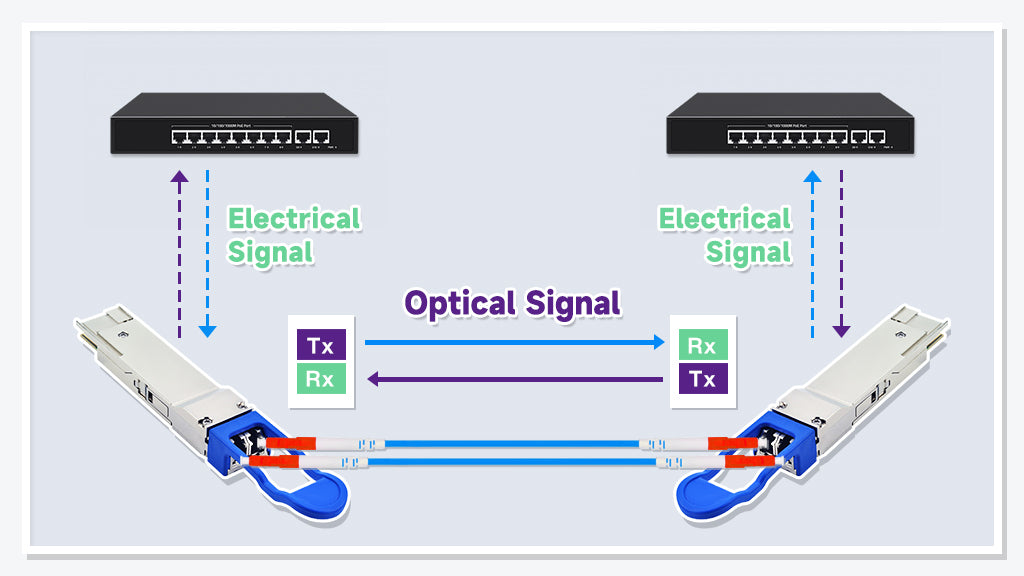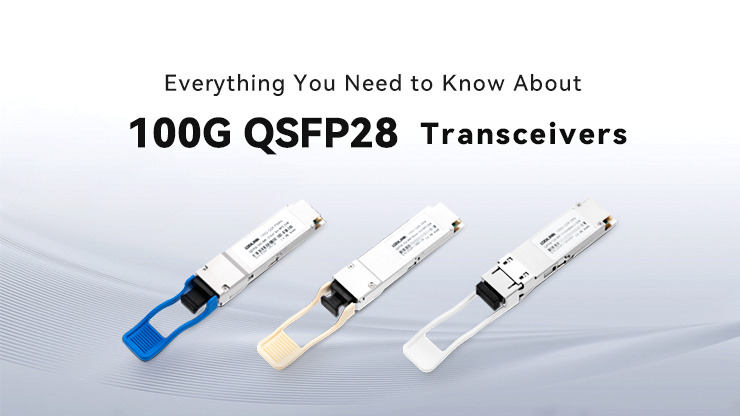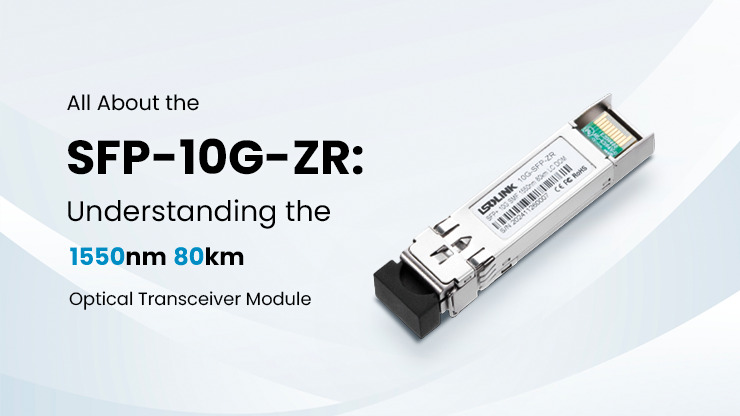Understanding Fiber Optic Transceivers
What is a Fiber Optic Transceiver?
What is a Fiber Optic Transceiver?
Optical Module, also called fiber optic module, is a hot-swappable module that integrates optical transceivers and receivers. Through optical fiber connection, the electrical-to-optical ands optical-to-electrical conversion of the signal is completed. It can support transmission at different distances and rates.
To be precise, the optical module is a general term for several types of modules, including: transmitter module, receiver module, transceiver module and transponder module. Usually what we call optical modules generally refers to fiber Optic Transceivers.
The Working Principle of Fiber Optic Transceivers
Optical transceivers operate at the physical layer of the OSI model and serve as core components in fiber optic communication systems. The transmitting interface inputs electrical signals at a specific data rate, which are processed by internal driver chips to modulate laser diodes (LD) or light-emitting diodes (LED) into corresponding optical signals. These light signals propagate through optical fibers before being converted back to electrical signals by photodetector diodes at the receiving interface. Finally, preamplifiers output the electrical signals at the original data rate.

Key Components Inside a Transceiver
An optical transceiver primarily consists of three key components:
- Optoelectronic Devices: Including the Transmitter Optical Sub-Assembly (TOSA) and Receiver Optical Sub-Assembly (ROSA).
- Functional Circuitry: The electrical IC (integrated circuit) responsible for signal processing and control.
- Optical/Electrical Interfaces: The physical ports for fiber connection (optical interface) and electrical signal input/output (electrical interface).
Why Are Fiber Transceivers Essential?
A fiber transceiver, short for transmitter-receiver, plays a pivotal role in modern networking by acting as an essential link between network devices. This compact yet sophisticated device serves as the intermediary between switches, routers, and cables, enabling seamless communication in various network setups.
Single-Mode vs Multi-Mode Transceivers: When to Use Which?
Differences in Transmission Distances and Optical Cables
The transmission distances of single-mode and multimode optical transceivers differ. Single-mode optical transceivers are typically used with single-mode optical cables and can transmit data over distances exceeding 10 km. In contrast, multimode optical transceivers are paired with multimode optical cables and are suitable for shorter distances, usually less than 2 km.
Operating Wavelengths and Optical Sources
To determine whether an optical transceiver is single-mode or multimode, you can tell from the wavelength: 850 nm, 1310 nm, and 1550 nm. These are common operating wavelengths for optical transceivers. The operating wavelengths vary with transceiver types. The operating wavelength of multimode optical transceivers is 850 nm, and that of single-mode optical modules is 1550 nm or 1310 nm.
Light-emitting diode (LED), Vertical-Cavity Surface-Emitting Laser (VCSEL), FD laser diodes, and distributed feedback (DFB) laser diodes are common optical sources. The first two are used by multimode optical transceivers, and the last two are used by single-mode optical transceivers.
Application Scenarios of Intranet or MAN
To determine whether an optical transceiver is single-mode or multimode, you can check its application scenarios. Multimode optical transceivers are used for shorter distances and are ideal for interconnections within data centers. Single-mode optical transceivers are well suited for long-distance metropolitan area network (MAN) transmissions.
The Complete Guide to Transceiver Form Factors (SFP, QSFP, CFP2…)
The History of Optical Transceiver Form Factors
Optical transceiver technology has come a long way from its early days. Initially, networks relied on 100Mbit and 1G solutions, with 10G being a high-cost, niche offering. Fast forward to today, and we now see 800G transceivers deployed on advanced form factors like OSFP and QSFP-DD, while 100G solutions deliver reliable performance over longer distances. Wavelength Division Multiplexing (WDM) has also become a central focus, driving greater capacity and efficiency in modern networks.
We take a closer look at the evolution of optical transceiver form factors, from the early GBIC models to the highly efficient SFP-DD, their development trajectory embodies miniaturization, high-speed, long-distance, cost-effectiveness, power efficiency, and hot-pluggability. All essential characteristics that have enabled the exponential growth of global data transmission.

Common Optical Transceiver Form Factors
There are 9 primary versions of the SFP, QSFP, and OSFP that allow different transmission speeds, and there are various models within each of those categories as well that offer varying connectors, distances, media, etc.
- SFP: Small Form-factor Pluggable. 100mb and 1Gbps transmissions over ethernet, as well as 2G and 4G over Fibre Channel. These modules offer RJ-45 or LC connectors and transmits/receives over a single channel. There are 9 different options differing by distance, media, and 2 that use the fiber strands differently (channel, lane, and path are used interchangeably).
- SFP+: Small Form-factor Pluggable Plus. This is an “enhanced” version of the SFP that supports data rates of 10Gbps, as well as 4G, 8G, and 16G over Fibre Channel.
- SFP28: Small Form-factor Pluggable 28. Also the same physical characteristics as the SFP and SFP+, but with an upgraded electrical interface that can handle 25Gbps per lane over ethernet and 32Gbps over Fibre Channel. All SFP28 transceivers utilize LC connectors.
- QSFP+: Quad Small Form-factor Pluggable. The “Quad” Small Form-Factor Pluggable (QSFP) introduces 4 channels over a single fiber in a slightly larger form-factor to allow 4x 10Gbps transmission totaling a 40Gbps throughput. The QSFP+ also introduces MPO and MPT connection options. MPO/MPT are capable of bundling multiple fibers in a single connector to support greater throughput.
- QSFP28: Quad Small Form-factor Pluggable 28. The QSFP28 simply added 4 channels using the SFP28 technology allowing 4x 25Gbps per channel to total 100Gbps throughput capability.
- QSFP56: Quad Small Form-factor Pluggable 56. The QSFP56 is a slightly more complex improvement of the QSFP28 and was designed to support 200Gbps of throughput. The primary change is the modulation technology which uses PAM-4 rather than NRZ. Without going too much into the details, just think of NRZ as having a maximum transmission value of 25Gbps where PAM-4 allows 50Gbps. Rather than 4x 25Gbps in the QSFP28, the QSFP56 transmits over 4 independent channels at 50Gbps totaling 200Gbps throughput.
- QSFP112: Quad Small Form-factor Pluggable 112. The QSFP112 pushes throughput capability to 400G.
- QSFP-DD: DD stands for Double Density, utilizing 8 channels with each channel supporting speeds up to 25Gb/s (NRZ modulation) or 50Gb/s (PAM4 modulation), delivering aggregate bandwidth of 200Gb/s or 400Gb/s.
- OSFP: Octal Small Form-factor Pluggable, where ‘O’ stands for octal, supporting 100Gb/s per channel.
How to Choose the Right Fiber Optic Transceiver?
Speed/Data Rate
Common data rates for transceivers include:
- 1Gbps – For small to medium-sized businesses and basic networking.
- 10Gbps – For enterprise networks and data centers.
- 25Gbps – Cost-effective for data centers needing server-to-switch links.
- 40Gbps – HPC and data center switch-to-switch connections.
- 100Gbps – For large data centers, core networking, interconnects, and storage.
- 200Gbps – For large-scale data centers, particularly in cloud environments and HPC.
- 400Gbps – Hyperscale data centers, high-capacity interconnects, and supercomputing.
- 800Gbps – For AI data centers, HPC, AI model training, and future-proong.
- 1.6T – coming soon
While higher data rates often seem better, balancing performance needs with cost and budget considerations is crucial.
Form factor & Connectors
- Small form-factor pluggable (1G SFP, 10G SFP+ )
- Small form-factor pluggable 28 (25G SFP28)
- Quad small form-factor pluggable (40G QSFP+)
- Quad small form-factor pluggable 28 (100G QSFP28)
- Quad small form-factor pluggable 25 dual density (200G QSFP28-DD)
- Quad small form-factor pluggable 50/56 dual density (400G QSFP56-DD)
- Quad small form-factor pluggable 112(400G QSFP112)
- Octal small form-factor pluggable (800G OSFP)
LC connectors are the most commonly used on transceivers, sometimes MPO and RJ-45 connections are also available when needed.
Check on Compatibility
There are a few different aspects of compatibility that you need to think about with your transceiver. Such as often easiest, is the form factor. How do the cables plug into the transceiver? There are many types of form factors available for different reasons, but the most popular still today are SFP, SFP+, SFP28, QSFP+, QSFP28, QSFP56, QSFP112, QSFP-DD, OSFP and so on.
There is also the issue of OEM compatibility. Each manufacturer can use its own proprietary signaling system, This is also one of the factors that need to be considered before making a choice.
Transceiver Types: Single-Mode vs. Multi- Mode
The choice between single-mode and multi-mode transceivers signicantly impacts network performance and cost. Single-mode transceivers’ ability to transmit over longer distances makes them ideal for connections between data centers or long-haul networks, but it will also cost more. Multi-mode transceivers, while limited in range, are often sucient and more economical for intra-data center connections.
Wavelength
Wavelength determines fiber optic performance:
- 850nm: ≤500m (multimode, short-distance transmission)
- 1310nm: ≤40km (standard single-mode)
- 1550nm: 40km+ (single-mode, long-haul, lowest loss)
Generally speaking, shorter wavelengths can hit higher speeds, but longer wavelengths can carry the signal farther.
Reach/Transmission Distance
Is your cable meters away from the signal source or kilometers away? Also, what max distance is your optic rated for? Short-reach transceivers are typically used in data centers, server clusters, core networks, or single-site facilities. Their lower cost makes them ideal for reducing capital and operational expenses in these environments. Longreach transceivers are employed for campus-to-campus or core-to-edge connections, often transmitting highly compressed WDM (Wavelength Division Multiplexing) signals over greater distances.
Frequently Asked Questions
Q: Can I connect a single-mode optical transceiver with a multimode transceiver?
A: Generally, no. Single-mode and multimode optical transceivers operate at different wavelengths and are designed for single-mode and multimode optical fibers respectively.
Q: Can I clean the optical transceiver?
A: Yes, when optical transceivers become contaminated, you can clean them with optical cleaning swabs, an optical cleaning solution, and clean dry air.
Q: What is the relationship between transceiver form factors and speed and distance?
A: Transceiver form factors are often associated with specific speed and distance capabilities. For example, SFP modules are commonly used for Gigabit Ethernet applications, while QSFP modules are used for 40 Gigabit Ethernet and higher-speed applications.
- PREV: Null
- NEXT: How to Choose the Right SFP Module for Your Network








